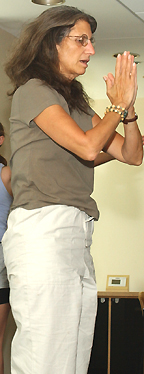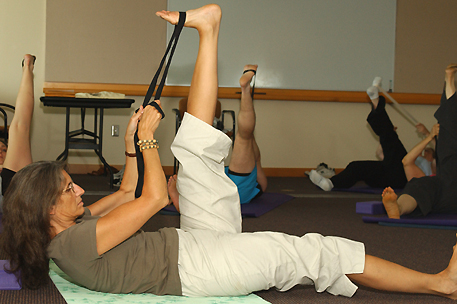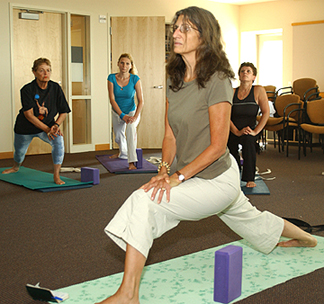
| T H E N I H C A T A L Y S T | S E P T E M B E R – O C T O B E R 2005 |
|
|
|
|
by Geoff Spemcer |
 |
|
Kate
Berg
|
 |
Intellectual flexibility has been a hallmark of Kate Berg’s NHGRI career.
Director of the Special Populations Research Program in the Medical Genetics Branch, Berg has searched for genes involved in attention def-icit hyperactivity disorder, chromosomal sites linked to hereditary prostate cancer, mutations related to holoprosen-cephaly, and, in particular, better ways to understand the genetic-environmental underpinnings of conditions affecting minorities and isolated populations.
But for one hour each Tuesday over the past two years, dozens of Clinical Center patients, family members, and NIH employees have benefited from a different yet equally flexible side of this intramural researcher: Kate the Yoga Instructor.
Relying on a few strategically placed mats and many positive minds to convert a no-nonsense conference room in the Hatfield Clinical Research Center into a calming yoga studio, Berg volunteers her time to teach people how to use yoga to focus on their minds and bodies—their selves—instead of worrying about treatment schedules, homesickness, and other elements beyond their control. Her class is among the activities made available by the Recreational Therapy service of the CC Department of Rehabilitation Medicine.
"The patients and families who come to my class are under a lot of stress. Maybe they’re a parent of a child with cancer or the brother of someone with a spinal cord injury; almost none have had yoga, but they hear that it’s stress reducing," says Berg. "Yoga is not going to cure them, but it will give them another tool for coping with disease in themselves or their family."
Accessible
The average in-patient stay in the Clinical Center is seven to eight days. Berg doesn’t often see patients more than once, but their reaction is nearly always the same. They come to her class claiming they’re not flexible enough to do yoga, and leave proclaiming they haven’t been so relaxed since coming to NIH. Often, they ask Berg where they can find a yoga instructor when they go home.
One secret to Berg’s success is that she makes her class accessible to everyone. At the beginning of each class, she asks each person if they have any health problems or physical limitations. She then picks yoga exercises based on the individual needs of her students. She provides props like blocks and straps for those who need additional support to get into some of the poses.
While there is little risk involved in yoga, people with certain medical conditions, such as detached retinas or high blood pressure, should not attempt certain yoga poses. Headstand, Berg observes, would not be wise for people who get migraine headaches. She cautions that anyone with a health condition should consult with his or her doctor before trying yoga.
"The class is safe for almost everyone because we can work around any physical issues," Berg says, adding that her students have ranged from age 9 to age 80-plus.
George Patrick, recreational therapy chief, is among Berg’s fans, often taking part in her yoga sessions. "Kate has a good calmness about her and she figured out that she needs to keep it simple. When patients are there, she’s very attentive to their [physical] needs and makes it easy enough for them to succeed," he says.
Different Kinds of Therapy
The yoga class is just one of many recreational therapies offered to CC patients and their families. Recreational therapists run programs to assist patients in adjusting to their disease, treatment, and hospitalization. Patients often have symptoms of boredom, depression, and anxiety.
Based on a patient’s individual needs, recreational therapists recommend they participate in activities, such as arts and crafts, music therapy, animal-assisted therapy, Tai Chi, or personal fitness.
According to Patrick, the classes are open to NIH staff as well as patients and their families. "The more the merrier. It really helps our patients to be part of a group. We have a few volunteers who teach classes and we encourage our own staff to participate as well so that patients know they are just ordinary people."
The names of the patients who attend the yoga class are given to their assigned recreational therapist, who can then follow up with the patient to see how the session went and to record the benefits they got from doing yoga.
Patrick says it is also a chance to encourage patients to continue an activity that is relaxing, peaceful, and focus driven.
"Yoga is really beneficial for rehabilitation by promoting posture, flexibility, and range of motion," says Patrick. "The key is getting patients to focus on taking care of themselves, and not thinking about anything else for at least 60 minutes, practicing a series of exercises to make them aware of right-to-left differences in their bodies. The body needs to be flexible; otherwise you’re more prone to injury and falls."
Without calling yoga a cure-all, Patrick sees it as a healing practice that has particularly beneficial effects on illness-related secondary symptoms, regardless of what the primary diagnosis is. Improved mood—related to reduced pain, tension, headache, or fatigue—is perhaps the most clearly observable effect for many patients.
Lessons from Patients
Berg has many stories about the patients she’s worked with and what they’ve been able to teach her. For example, about a year ago, she had a patient with very limited physical mobility who had taken yoga classes regularly and was glad to have a chance to continue them at NIH. She showed Berg some adaptations to the shoulder stand and bridge poses that were so effective that Berg now teaches them to all her students, whether or not they have limited mobility. "I think of her every time I do either of those poses," Berg says.
Another time, two cancer patients under treatment at the Clinical Center joined the class at the same time. The woman was wearing a wig; the man, a hat. As soon as they got into the class, they pulled off their head coverings. The woman, completely bald, was exquisitely beautiful—much more so without the wig, according to Berg. She had done yoga before her illness, and Berg watched over the weeks as she gained back her strength and was able to go deeper into the poses.
The man was very ill. He could only sit quietly and breathe with difficulty, but he stayed in the class until it ended and came back several more times. What particularly touched Berg was that each time these patients came they removed their head coverings for class and then carefully put them back on before leaving. They clearly felt comfortable in the class.
Perhaps what makes people feel most welcome is Berg’s gentle reminder at the start of each class that "it’s not a competition"—everyone has options, and no one needs to do every pose.
 |
 |
The Path to Yoga’s Paths
Berg’s affinity for yoga dates back to her childhood. Before she’d even heard of yoga, she’d naturally assume yoga-like poses, such as sitting with her legs folded in the lotus position or reading lying on her back in a supported shoulder stand. Berg began actively studying yoga while in college, and about 10 years ago, she started practicing it every day and reading yoga texts.
Eventually, she spent a yearlong apprenticeship under a yoga instructor so she could teach yoga to others.
Berg is trained in a style of yoga called "Sivananda," which includes meditation, yoga poses called "asanas," and breathing exercises called "pranayama." It is named after Swami Sivananda, a yoga master from India who lived from 1887 to 1963 and whose teachings have influenced practitioners of yoga all over the world.
Sivananda teaches four paths of yoga, one known as "karma" yoga. Karma yoga is the practice of selflessness, without thoughts of gaining something in return. It is this path of yoga that led Berg to volunteer to teach the yoga class at the Clinical Center.
She has dubbed her particular brand of yoga instruction there a "Sivananda hybrid," a modification of classic Sivananda that avoids certain poses that might be too taxing and is especially careful to accommodate limitations.
At the end of this year, Berg will retire from NIH and will no longer teach the yoga class at the Clinical Center. However, she will continue to offer classes at the yoga studio she has created in her Silver Spring home and plans on doing some writing about the health aspects of yoga and meditation.
She and Patrick are looking around for someone to replace her at the CC yoga "studio." Berg feels she will be leaving the next instructor a gift.
"I get so much out
of [teaching this yoga class]," says Berg, "so much satisfaction."
![]()